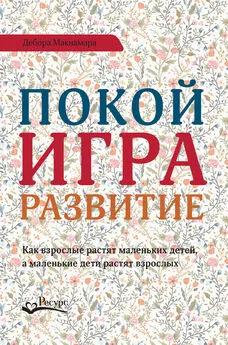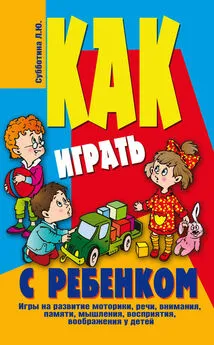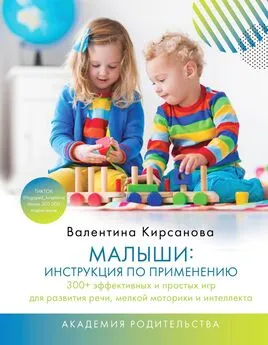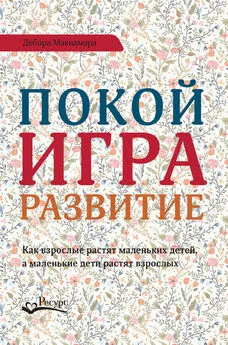Дебора Макнамара - Покой, игра, развитие
- Название:Покой, игра, развитие
- Автор:
- Жанр:
- Издательство:Литагент Издательство Ресурс
- Год:2016
- Город:Москва
- ISBN:978-5-9906512-7-2
- Рейтинг:
- Избранное:Добавить в избранное
-
Отзывы:
-
Ваша оценка:
Дебора Макнамара - Покой, игра, развитие краткое содержание
Основная проблема человека заключается в том, что не все мы взрослеем, становясь старше. Автор убедительно доказывает, что только понимая незрелость дошкольников – чего им недостает и почему, – мы сможем осознать значение условий, благоприятных для истинного взросления, а значит, сможем разобраться в самих себе и выполнить задачу воспитания детей. Ведь, если мы знаем, что нужно Природе и можем обеспечить эти условия, то мы позволим себе немного расслабиться, а затем и порадоваться спонтанно созревающим плодам.
Покой, игра, развитие - читать онлайн бесплатно ознакомительный отрывок
Интервал:
Закладка:
74
Браун Стюарт и Воган Кристофер, Игра…; Frost, Neuroscience, play, and child development.
75
Campaign for a Commercial Free Childhood, Alliance for Childhood, and Teachers Resisting Unhealthy Children’s Entertainment, Facing the Screen Dilemma: Young Children, Technology and Early Education (Boston: Campaign for a Commercial-Free Childhood; New York: Alliance for Childhood, 2012).
76
Bruce D. Perry, Lea Hogan, and Sarah J. Marlin, Curiosity, pleasure and play: A neurodevelopmental perspective // Haaeyc Advocate 20 (2000): 9–12.
77
Perry, Hogan, and Marlin, Curiosity, pleasure and play.
78
Ginsburg et al., The importance of play.
79
Frost, Neuroscience, play, and child development.
80
Jaak Panksepp, Brain emotional systems and qualities of mental life, in Diana Fosha, Daniel J. Siegel, and Marion Fried Solomon, eds., The Healing Power of Emotion: Affective Neuroscience, Development, and Clinical Practice (New York: W. W. Norton, 2009), рр. 1–26.
81
Ginsburg et al., The importance of play.
82
Ginsburg et al., The importance of play; Panksepp, Brain emotional systems; Peter Gray, The decline of play and the rise of psychopathology in children and adolescents // American Journal of Play 3 (2011): 443–63.
83
Falk, ed., Defending Childhood .
84
Sandra L. Hofferth and John F. Sandberg, Changes in American children’s time, 1981–1997 // Advances in Life Course Research 6 (2001): 193–229.
85
Ginsburg et al., The importance of play.
86
Campaign for a Commercial Free Childhood et al., Facing the Screen Dilemma .
87
American Academy of Pediatrics, Media and children (2015), https://www.aap.org/en-us/advocacy-and-policy/aap-health-initiatives/pages/media-and-children.aspx.
88
Campaign for a Commercial Free Childhood et al., Facing the Screen Dilemma .
89
Ричард Лоув, Последний ребенок в лесу: как спасти наших детей от синдрома дефицита общения с природой (М.: «Добрая книга», 2007).
90
Elkind D., Can we play?
91
Joe L. Frost, A History of Children’s Play and Play Environments: Toward a Contemporary Child-Saving Movement (New York: Routledge, 2009); Participaction, Position Statement on Active Outdoor Play (2015), http://www.participaction.com/wp-content/uploads/2015/03/Position-Statement-on-Active-Outdoor-Play-EN-FINAL.pdf.
92
American Academy of Pediatrics, Babies as young as 6 months using mobile media (25 April 2015), http://www.aappublications.org/content/early/2015/04/25/aapnews.20150425–3.
93
Nancy Carlsson-Paige, Media, technology, and commercialism: Countering the threats to young children, in Falk, ed., Defending Childhood .
94
Frost, A History of Children’s Play , p. XVIII.
95
Thomas S. Dee and Hans Henrik Sievertsen, The gift of time? School starting age and mental health, CEPA Working Paper No. 15–08, Stanford Center for Education Policy Analysis, Stanford University, Stanford, CA (October 2015), https://cepa.stanford.edu/sites/default/fi les/WP15–08.pdf.
96
Gray, Free to Learn .
97
National Association for the Education of Young Children, The Common Core State Standards: Caution and Opportunity for Early Childhood Education (Washington, DC: National Association for the Education of Young Children, 2012).
98
Professional Association for Childcare and Early Years, Concern over ‘schoolification’ (9 July 2013), https://www.pacey.org.uk/news-and-views/news/archive/2013-news/july-2013/concern-over-schoolification/.
99
Sophie Alcock and Maggie Haggerty, Recent policy developments and the ‘schoolification’ of early childhood care and education in Aotearoa New Zealand // Early Childhood Folio 17, №. 2 (2013): 21–26.
100
Bryndis Gunnarsdottir, From play to school: Are core values of ECEC in Iceland being undermined by ‘schoolification’? // International Journal of Early Years Education 22 (2014): 242–250; Dorota Lembrer and Tamsin Meaney, Socialisation tensions in the Swedish preschool curriculum: The case of mathematics // Educare 2 (2014): 82–98.
101
Christine Gross-Loh, Finnish education chief: We created a school system based on equality // The Atlantic (17 марта 2014), http://www.theatlantic.com/education/archive/2014/03/finnish-education-chief-we-created-a-school-system-based-on-equality/284427/.
102
Tim Walker, The joyful, illiterate kindergartners of Finland // The Atlantic (1 October 2015), http://www.theatlantic.com/education/archive/2015/10/the-joyful-illiterate-kindergartners-of-finland/408325/.
103
Council of Ministers of Education, Canada (CMEC), Programme for International Student Assessment (PISA): Overview (n.d.), http://www.cmec.ca/251/Programs-and-Initiatives/Assessment/Programme-for-International-Student-Assessment-(PISA)/Overview/index.html; см. также различные документы о результатах PISA–2012 здесь: http://www.cmec.ca/252/Programs-and-Initiatives/Assessment/Programme-for-International-Student-Assessment-(PISA)/PISA-2012/index.html.
104
Mary-Louise Vanderlee, Sandy Youmans, Ray Peters, and Jennifer Eastabrook, Final Report: Evaluation of the Implementation of the Ontario Full-Day Early Learning – Kindergarten Program ([Toronto]: Ontario Ministry of Education, осень 2012), http://www.edu.gov.on.ca/kindergarten/FDELK_ReportFall2012.pdf; Magdalena Janus, Eric Duku, and Amanda Schell, The Full-Day Kindergarten Early Learning Program: Final Report (Hamilton, ON: McMaster University, октябрь 2012), http://www.edu. gov.on.ca/kindergarten/ELP_FDKFall2012.pdf.
105
Harris Cooper, Ashley Batts Allen, Erica. A. Patall, and Amy L. Dent, Effects of full-day kindergarten on academic achievement and social development // Review of Educational Research 80 (2010): 34–70.
106
James Heckman, Invest in early childhood development: Reduce deficits, strengthen the economy // The Heckman Equation (2012), http://heckmanequation.org/content/resource/invest-early-childhood-development-reduce-dficits-strengthen-economy.
107
Christopher Clouder, The push for early childhood literacy: A view from Europe, Research Institute for Waldorf Education // Research Bulletin 8, № 2 (2003): 46–52; Comptroller and Auditor General, National Audit Office, Delivering the Free Entitlement to Education for Three-and Four-Year-Olds (London: The Stationery Office, 2012).
108
Joan Almon, Nancy Carlsson-Paige, and Geralyn B. McLaughlin, Reading Instruction in Kindergarten: Little to Gain and Much to Lose (Alliance for Childhood; Defending the Early Years, 2015), https://deyproject.files.wordpress. com/2015/01/readinginkindergarten_online-1.pdf.
109
Clouder, The push for early childhood literacy.
110
Joan Almon, Reading at five: Why? SouthEast Education Network // SEEN Magazine (21 августа 2013), http://seenmagazine.us/articles/article-detail/articleid/3238/reading-at-five-why.aspx.
111
Elkind D., Can we play?
112
Процитировано в статье: Valerie Strauss, How ‘twisted’ early childhood education has become – from a child development expert // Washington Post (24 November 2015), https://www.washingtonpost.com/news/answer-sheet/wp/2015/11/24/how-twisted-early-childhood-education-has-become-from-a-child-development-expert/.
113
Льюис К. С., Любовь (М.: Эксмо, 2011).
114
Элиот Т. С., Ист Коукер, Четыре квартета (СПб.: ИД «Кристалл», 2000).
115
Ньюфелд Г., Интенсив I: Понимать детей / курс (Институт Ньюфелда, Ванкувер, 2013), http://neufeldinstitute.org/course/ neufeld-intensive-i-making-sense-of-kids/.
116
Jaak Panksepp and Lucy Biven, The Archaeology of Mind: Neuroevolutionary Origins of Human Emotions (New York: W. W. Norton, 2012).
117
Kerstin Uvnäs Moberg, The Oxytocin Factor: Tapping the Hormone of Calm, Love, and Healing (Cambridge, MA: Da Capo Press, 2003).
118
Panksepp and Biven, The Archaeology of Mind .
119
John Bowlby, Attachment and Loss (New York: Basic Books, 1969).
120
Bowlby, Attachment and Loss .
121
Dorothy Corkille Briggs, Your Child’s Self-Esteem: The Key to His Life (Garden City, NJ: Doubleday, 1970), стр. 55.
122
Lise Eliot, What’s Going On in There? How the Brain and Mind Develop in the First Five Years of Life (New York: Bantam Books, 2000).
123
Деревня привязанностей ( attachment village ) – сеть привязанностей, формирующих контекст воспитания ребенка. В традиционных обществах деревне привязанностей соответствовала та деревня, в которой люди фактически жили и растили детей. В нашем обществе нам нужно самим создавать деревню привязанностей.
124
Винникот Д. В. и Винникот Клер, Разговор с родителями (М.: «Класс», 2012).
125
Танец, ритуал завладевания, танец привязанности (collecting dance) – термин означает инстинктивный механизм ухаживания, действия, направленные на то, чтобы вызвать в других привязанность. Для того, чтобы отношения между родителем и ребенком выполняли свое предназначение, они должны быть выстроены иерархически. Когда в отношениях родитель является ведущим, а ребенок ведомым, тогда возникает очень комфортный для обеих сторон «танец привязанности», который приносит удовлетворение как ребенку, так и взрослому.
Читать дальшеИнтервал:
Закладка:







